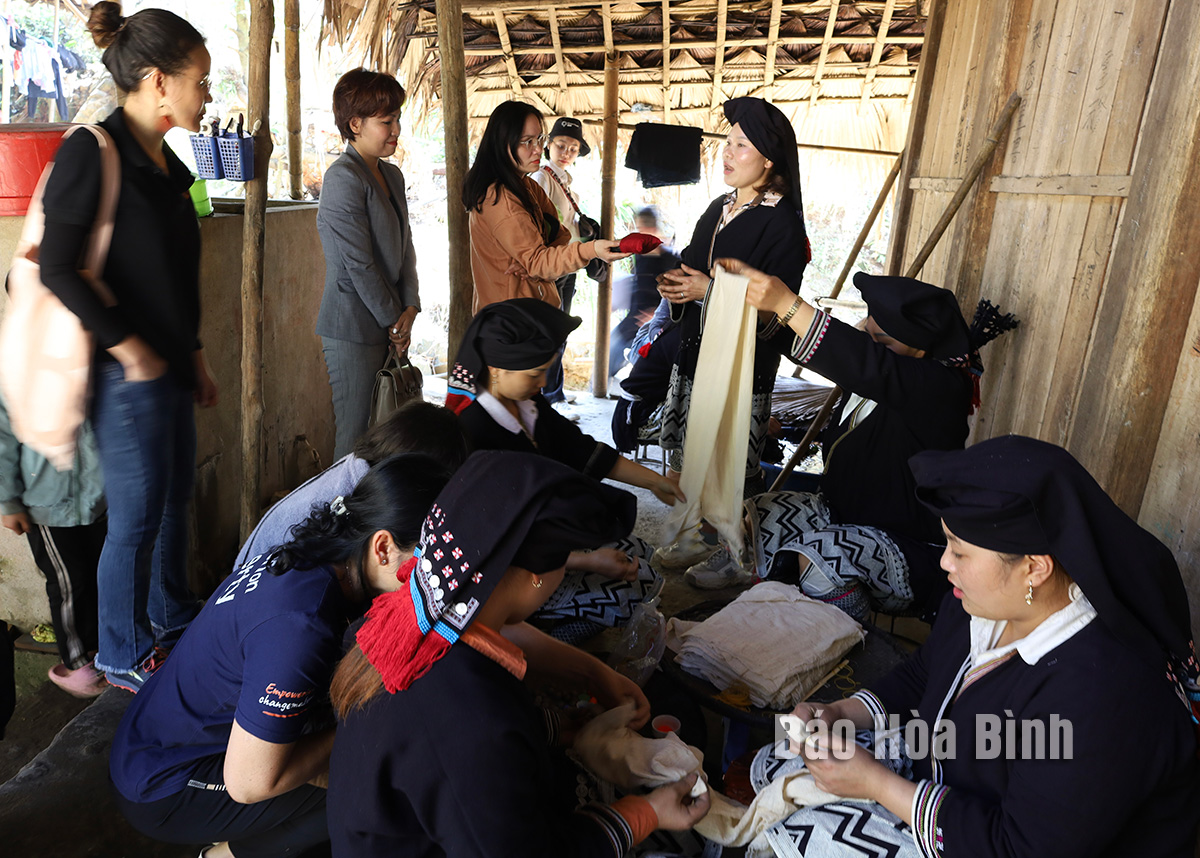
With a diverse culture with the identities of the Muong, Tay, Dao, and Thai ethnic groups and wild, majestic landscapes, Da Bac highland district is developing diverse tourism, associated with preserving and promoting traditional culture.

Tourists visit Sung hamlet, Cao Son commune, Da Bac district.
Comrade Nguyen Van Toan, Head of the Culture and Information Department of Da Bac district, said: Some scenic spots of the district are being exploited to serve tourism development, such as: Thac Bo temple in Vay Nua commune, Coconut Island tourist area is one of the most beautiful islands in the Hoa Binh lake area.
A scenic spot that many international tourists discover is Pu Canh Nature Reserve. The reserve is located in the communes: Doan Ket, Yen Hoa, Dong Ruong, Dong Chum with a total area of over 1,580 hectares with rich flora and fauna ecosystems, waterfalls, stream systems and remaining primary forests. There are ancient trees hundreds of years old here. The foot of Pu Canh mountain is home of the Tay and Muong ethnic people with many unique cultural features from costumes, writing, cuisine... The people are friendly.
From 2017 up to now, in the villages along Hoa Binh lake, a number of community tourism destinations for the Muong and Dao ethnic people have been formed. Among them is the community tourism site in Ke hamlet, Hien Luong commune. There are 4 homestay in the village: Sac Luyen, Sanh Thuan, Huu Thao, and Ha Khanh. Visitors coming here can experience life with the Muong ethnic people with activities like cycling, swimming, kayaking, fishing and shrimping...
The community tourist destination in Sung hamlet, Cao Son commune is inhabited by the Dao Tien people. The village here has wild beauty, ethnic people retain many traditional cultural activities, creating unique and typical tourism products, attracting a large number of international tourists to discover.
Da Bia community tourism site, Tien Phong commune is a famous tourist village that has been recognized with the 2019 Asean community tourism award. Coming to Da Bia, visitors can enjoy culinary dishes of the Muong people: grilled fish, bamboo-tube rice, hill chicken, wild vegetables... or experience the "self-conscious" restaurant.
In Da Bac district, there are a number of tourist and resort areas that many tourists choose: Mai Da Lodge in Doan Ket hamlet - Tien Phong commune; Xoan Retreat Da Bac in Mo hamlet, Da Bac Ecolodge in Mai hamlet, Hien Luong commune; Ho Tam homestay in Cao Son commune.
In addition, visitors to Da Bac can also discover nice caves and waterfalls, such as: Lo Lan cave - Hien Luong commune, Ho Vang cave - Nanh Nghe commune, Sung cave - Cao Son commune, Bong waterfall - Tan Minh commune.
A diverse chain of eco-tourism and resort destinations concentrated in Hoa Binh city and the districts of Tan Lac, Da Bac, and Luong Son… Along with the launch of several key high-quality resort tourism projects, these developments have reshaped the landscape and enhanced the appeal of Hoa Binh as a travel destination.
Boasting diverse terrain, a mild climate, and rich natural resources, Cao Phong district is increasingly asserting its place on Vietnam’s tourism map, attracting both domestic and foreign visitors. The district is renowned for its stunning landscapes, majestic mountains, a crystal-clear hydropower lake, and the unique cultural identity of local ethnic groups.
With its pristine landscapes, unique cultural heritage of Muong ethnic minority, and an expanding range of visitor experiences, Tan Lac district of Hoa Binh has fast become a captivating destination for both domestic and international tourists.
Until now, Sung village in Cao Son commune, Da Bac district remains the only Dao ethnic community in Hoa Binh province to develop a community-based tourism model. Beyond its untouched natural landscapes, cultural identity serves as the cornerstone attraction for visitors.
Alongside the diverse cultural identities of the Kinh, Muong, Tay, Thai, Dao, and Mong ethnic people, Hoa Binh province is also renowned as the "capital" of the northwestern Vietnamese cuisine, offering unique and distinctive dishes. At festivals, during Lunar New Year (Tet), or on significant family or community occasions, special dishes are prepared, leaving a lasting impression on visitors.
A Phong Linh (Yellow Tabebuia) flower garden in Thang village, Thach Yen commune, Cao Phong district is currently in full bloom, drawing a large number of visitors.



